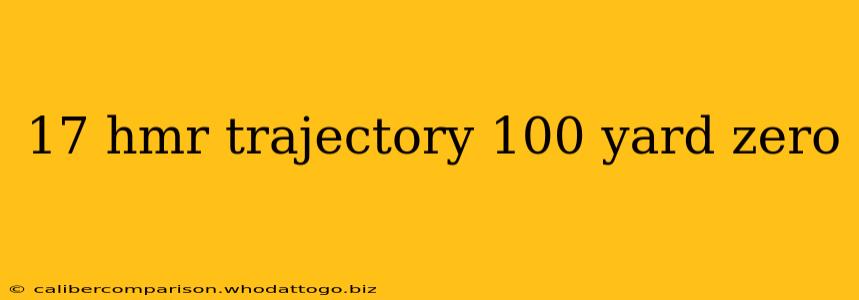The .17 HMR (Hornady Magnum Rimfire) cartridge is a popular choice for varmint hunting and target shooting, prized for its flat trajectory and impressive accuracy at longer ranges. Understanding its trajectory, particularly when zeroing at 100 yards, is crucial for making accurate shots at varying distances. This guide delves into the specifics of .17 HMR ballistics, focusing on the implications of a 100-yard zero.
Understanding Trajectory
Trajectory refers to the path a projectile takes through the air from the moment it leaves the barrel until it impacts the target. Several factors influence a bullet's trajectory, including:
- Muzzle Velocity: The speed at which the bullet exits the barrel. Higher muzzle velocity generally results in a flatter trajectory.
- Bullet Weight: Heavier bullets are less affected by wind and generally have a flatter trajectory, though often with slightly lower velocity.
- Ballistic Coefficient (BC): A measure of a bullet's aerodynamic efficiency. A higher BC means less air resistance and a flatter trajectory.
- Air Density: Higher air density (e.g., at lower altitudes or colder temperatures) increases air resistance, affecting trajectory.
- Wind: Wind significantly impacts bullet trajectory, causing drift.
The 100-Yard Zero: Advantages and Disadvantages
A 100-yard zero for the .17 HMR represents a compromise. It offers a relatively flat trajectory out to a moderate range but necessitates understanding bullet drop at shorter and longer distances.
Advantages:
- Acceptable Accuracy at Medium Ranges: The 100-yard zero provides consistent point-of-impact (POI) across a useful hunting range, generally within 50-150 yards, depending on the specific ammunition used. Holdovers or adjustments are minimal within this range.
- Reduced Holdover/Hold Under: Compared to a shorter zero (e.g., 50 yards), the 100-yard zero necessitates less compensation for bullet drop at distances beyond the zero range.
Disadvantages:
- Significant Drop at Shorter Ranges: The bullet will impact significantly below the point of aim at distances closer than 100 yards, demanding significant holdover adjustments.
- Increasing Drop at Longer Ranges: While still reasonably accurate beyond 100 yards, bullet drop increases more rapidly at distances beyond the 100-yard zero. Accurate shots at longer ranges require precise holdover adjustments or the use of a ballistic calculator.
Factors Affecting 100-Yard Zero Trajectory
Several variables influence the exact trajectory of a .17 HMR with a 100-yard zero:
- Ammunition: Different .17 HMR ammunition manufacturers produce cartridges with varying muzzle velocities and bullet weights, leading to differences in trajectory. Always consult the specific ammunition's ballistic data.
- Rifle Characteristics: The rifle's barrel length, twist rate, and even the condition of the barrel can slightly impact muzzle velocity and accuracy.
- Environmental Conditions: Temperature, air pressure, and wind speed greatly influence trajectory. These variables need to be considered for precise shooting.
Practical Implications and Best Practices
- Zeroing Procedure: Proper zeroing requires careful sighting-in at 100 yards using a stable shooting rest and consistent shooting technique. Multiple shots should be fired to establish an accurate zero.
- Ballistic Calculators and Apps: Numerous ballistic calculators and smartphone apps are available, providing precise trajectory data based on your specific ammunition, rifle, and environmental conditions. These tools are invaluable for calculating holdovers.
- Practice: Regular practice at varying distances is essential to develop the skills necessary to effectively utilize a 100-yard zero. This will help you understand how to compensate for bullet drop and wind drift.
By understanding the intricacies of .17 HMR trajectory and the implications of a 100-yard zero, shooters can enhance their accuracy and success in the field or at the range. Remember to prioritize safety and always consult your ammunition's ballistic data for the most precise information.

